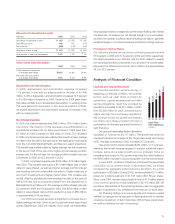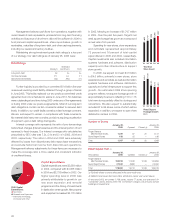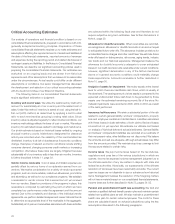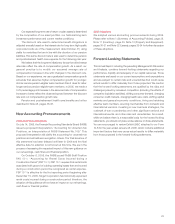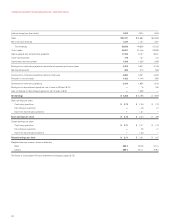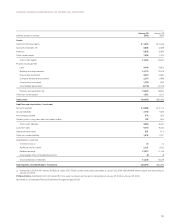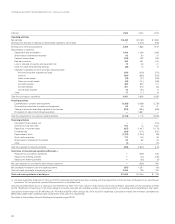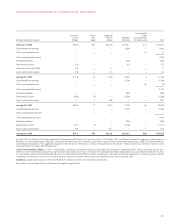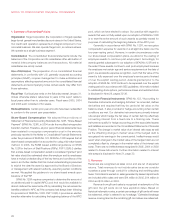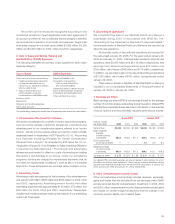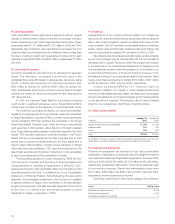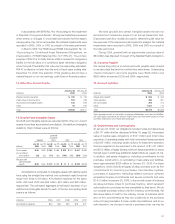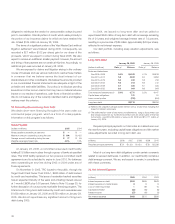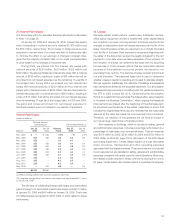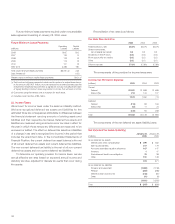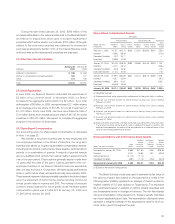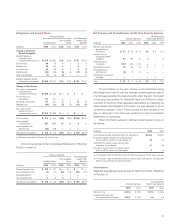Target 2005 Annual Report Download - page 30
Download and view the complete annual report
Please find page 30 of the 2005 Target annual report below. You can navigate through the pages in the report by either clicking on the pages listed below, or by using the keyword search tool below to find specific information within the annual report.
28
1. Summary of Accounting Policies
Organization Target Corporation (the Corporation or Target) operates
large-format general merchandise discount stores in the United States.
Our credit card operation represents an integral component of our
core retail business. We also operate Target.com, an online business.
We operate as a single business segment.
Consolidation The consolidated financial statements include the
balances of the Corporation and its subsidiaries after elimination of
material intercompany balances and transactions. All material
subsidiaries are wholly owned.
Use of Estimates The preparation of our consolidated financial
statements, in conformity with U.S. generally accepted accounting
principles (GAAP), requires management to make estimates and
assumptions affecting reported amounts in the consolidated financial
statements and accompanying notes. Actual results may differ from
those estimates.
Fiscal Year Our fiscal year ends on the Saturday nearest January 31.
Unless otherwise stated, references to years in this report relate to
fiscal years rather than to calendar years. Fiscal years 2005, 2004
and 2003 each consisted of 52 weeks.
Reclassifications Certain prior year amounts have been reclassified
to conform to the current year presentation.
Share-Based Compensation We adopted the provisions of
Statement of Financial Accounting Standards No.123R, “Share-Based
Payment” (SFAS No.123R), in 2004 under the modified retrospective
transition method. Therefore, all prior period financial statements have
been restated to recognize compensation cost in the amounts
previously reported in the Notes to Consolidated Financial Statements
under the provisions of SFAS No.123. SFAS No.123R requires that all
share-based compensation be accounted for using a fair-value-based
method. In 2005, the FASB issued additional guidance on SFAS
No.123R in the form of Staff Positions (FSPs). FSP 123(R)-2 clarifies
that a share-based compensation award is considered “granted” (and
fair value should be estimated) when the employer and its employees
have a mutual understanding of the key terms and conditions of the
award, and further clarifies that this mutual understanding is presumed
to exist at the date the award is approved by the Board of Directors
or management with relevant authority, assuming certain conditions
are met. We applied this guidance to our share-based awards upon
issuance of the FSP.
SFAS No.123R requires companies to determine the amount of
an additional paid-in capital (APIC) pool that would be available to
absorb deferred tax asset write-offs by calculating the net excess tax
benefits credited to APIC as if the company had always been following
the provisions of SFAS No.123R. FSP 123(R)-3 provides an elective
transition alternative for calculating the beginning balance of the APIC
pool, which we have elected to adopt. Our practice with regard to
awards that were not fully vested upon our adoption of SFAS No.123R
is to treat the entire amount of such awards as partially vested for
purposes of calculating the beginning balance of the APIC pool.
Generally, in accordance with SFAS No.123R, we recognize
compensation expense for awards on a straight-line basis over the
four-year vesting period. However, in certain circumstances under
our share-based compensation plans, we allow for the vesting of
employee awards to continue post-employment. Accordingly, for
awards granted subsequent to our adoption of SFAS No.123R and to
the extent those awards continue to vest post-employment because
the employee met certain age and service requirements at the date of
grant, we accelerate expense recognition, such that the value of the
award is fully expensed over the employee’s service period instead
of over the explicit vesting period. Awards granted prior to the
adoption of SFAS No.123R continue to be expensed over the explicit
vesting period in accordance with SEC guidelines. Information related
to outstanding stock options, performance shares and restricted stock
is disclosed in Note 26, pages 35-36.
Derivative Financial Instruments SFAS No.133, “Accounting for
Derivative Instruments and Hedging Activities,” as amended, defines
derivatives and requires that they be carried at fair value on the
balance sheet. It also provides for hedge accounting when certain
conditions are met. Our derivative instruments are primarily interest
rate swaps which hedge the fair value of certain debt by effectively
converting interest from a fixed rate to a floating rate. These
instruments qualify for hedge accounting and the associated assets
and liabilities are recorded in the Consolidated Statements of Financial
Position. The change in market value of an interest rate swap as well
as the offsetting change in market value of the hedged debt is
recognized into earnings in the current period. Ineffectiveness would
result when changes in the market value of the hedged debt are not
completely offset by changes in the market value of the interest rate
swap. There was no ineffectiveness recognized in 2005, 2004 or 2003
related to these instruments. Further information related to interest
rate swaps is disclosed in Note 21, page 33.
2. Revenues
Revenues are recognized as sales occur and are net of expected
returns. Total revenues do not include sales tax as we consider
ourselves a pass-through conduit for collecting and remitting sales
taxes. Commissions earned on sales generated by leased departments
are included within sales and were $14 million in 2005, $14 million in
2004 and $13 million in 2003.
Revenue from gift card sales is recognized at redemption of the
gift card. Our gift cards do not have expiration dates. Based on
historical redemption rates, a certain percentage of gift cards will never
be redeemed, which is referred to as “breakage.” Estimated breakage
revenue is recognized as the remaining gift card values are redeemed.
NOTES TO CONSOLIDATED FINANCIAL STATEMENTS



